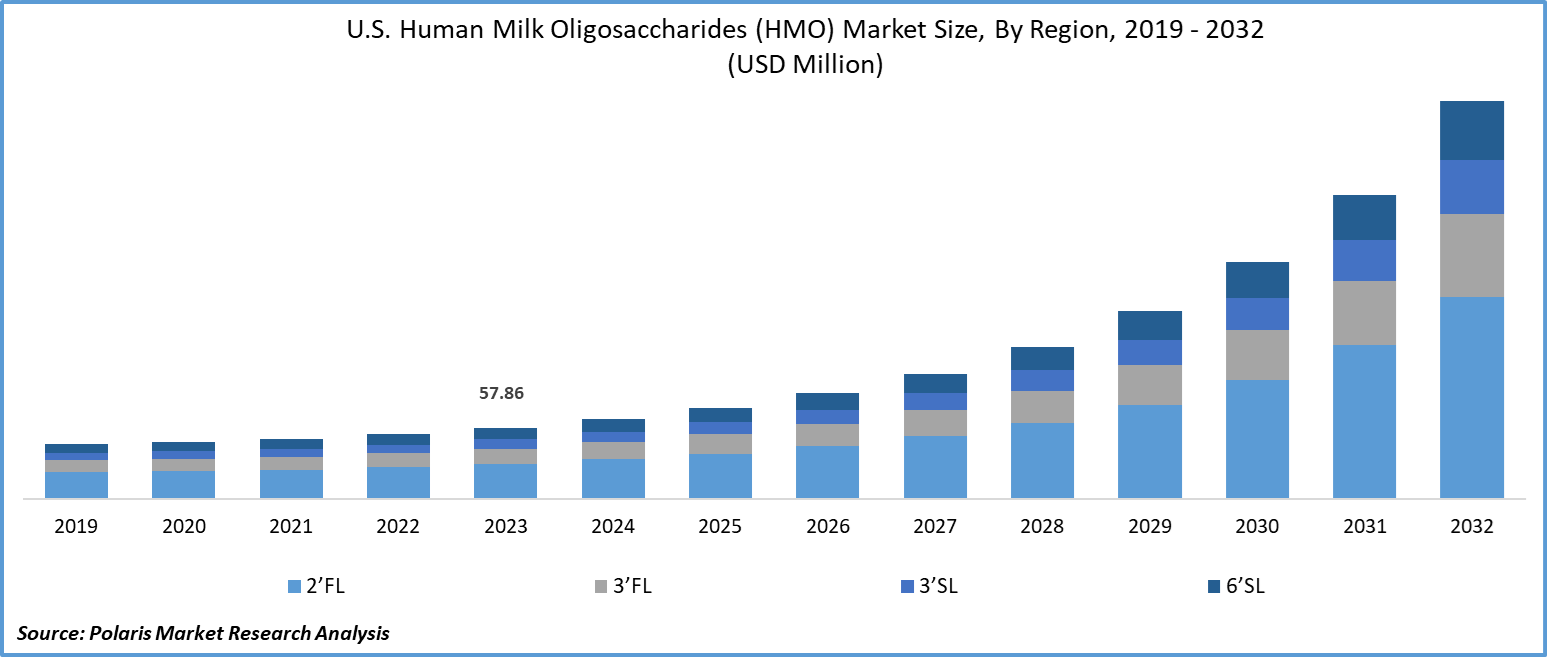The global human milk oligosaccharides (HMO) market size is expected to reach USD 1303.59 million by 2032, expected to grow at a CAGR of 22.6% during the forecast period.
The Human Milk Oligosaccharides (HMO) Market refers to the segment focused on the production, commercialization, and consumption of oligosaccharides found in human breast milk. These oligosaccharides are complex carbohydrates that play a crucial role in infant nutrition, supporting gut health, immune function, and cognitive development. HMOs are recognized as one of the most abundant bioactive components in human milk, with numerous health benefits.
Market Growth Drivers
- Increasing Demand for Infant Formula:
The primary driver for the HMO market is the growing demand for infant formula. As more parents seek alternatives to breast milk due to medical conditions, lifestyle choices, or other reasons, infant formula manufacturers are incorporating HMOs to mimic the nutritional benefits of human milk. This trend is particularly strong in emerging markets where access to breastfeeding support and healthcare infrastructure may be limited. - Health Benefits of HMOs:
Research has highlighted the numerous health benefits of HMOs, including their role in promoting gut health, strengthening the immune system, and enhancing cognitive development. HMOs serve as prebiotics, helping to foster beneficial gut bacteria and protecting against harmful pathogens. As awareness of these benefits grows, more parents and caregivers are turning to HMO-enriched products to support their children’s health. - Rising Awareness of Infant Health:
With the rising awareness of infant health and development, there has been a shift towards products that support early-stage nutrition. Parents are becoming more conscious of the ingredients in baby foods and infant formulas, with a preference for products that include natural, bioactive ingredients like HMOs, which are closely associated with breast milk.
Some of the major players operating in the global market include:
- Elicityl S.A.
- Abbott Laboratories
- Biosynth Carbosynth
- Dextra Laboratories Ltd.
- Dupont Nutrition & Biosciences
- Glycosyn
- BASF S.E.
- Glycom A/S
- Nestle Health Science
- Neolacta Lifesciences Pvt. Ltd
Download Free Sample PDF Copy of the Report:
Key Trends
- Incorporation of HMOs in Adult and Functional Foods:
Initially, HMOs were primarily associated with infant nutrition, but recent trends show that they are increasingly being included in functional foods and beverages designed for adults. This includes dietary supplements aimed at improving gut health, immune support, and even cognitive function. As research continues to demonstrate the health benefits of HMOs, the market is expanding beyond just infant nutrition. - Focus on Sustainability in HMO Production:
As sustainability becomes a key concern for both consumers and manufacturers, there is increasing pressure to adopt environmentally friendly practices in HMO production. Companies are investing in sustainable production methods, including reducing water and energy usage during fermentation processes and using renewable resources for HMO production. - Regulatory Developments and Safety Standards:
Governments and regulatory bodies are setting higher standards for the use of HMOs in food and beverages, particularly for infant nutrition. As the market grows, ensuring the safety and efficacy of HMO-enriched products becomes paramount. This has led to an increase in clinical research and trials to support the health claims associated with HMOs.
Recent Developments
- In June 2021, H&H Group, an Australian company, introduced a new kids’ supplement named ProBOOST + Vit D under Biostime. This innovative product contains Human Milk Oligosaccharides (HMOs) and is specifically formulated for children aged 12 months and above. This launch highlights H&H Group’s commitment to providing high-quality nutritional supplements that incorporate HMOs to support the health and development of children.
- In April 2020, the company Kyowa Hakko, which specializing in health products, expanded its production capabilities for HMOs in Thailand. This strategic move was driven by the anticipated global increase in the market for these health products in the upcoming years.
𝐒𝐞𝐠𝐦𝐞𝐧𝐭𝐚𝐥 𝐀𝐧𝐚𝐥𝐲𝐬𝐢𝐬:
The research study includes segmental analysis that divides the market into distinct groups or segments based on common characteristics. With market segmentation, businesses can identify specific customer groups that are more likely to be interested in specific products or services. Also, it enables these businesses to focus their marketing efforts and resources more efficiently, leading to higher conversion rates and improved return on investment. Furthermore, segmentation analysis helps companies develop personalized products or services, which can result in increased customer loyalty and improved customer satisfaction.
Human Milk Oligosaccharides (HMO), Type Outlook (Revenue – USD Million, 2019 – 2032)
- 2’FL
- 3’FL
- 3’SL
- 6’SL
Human Milk Oligosaccharides (HMO), Application Outlook (Revenue – USD Million, 2019 – 2032)
- Infant Formula
- Functional Food & Beverage
- Food Supplements
Human Milk Oligosaccharides (HMO), Distribution Channel Outlook (Revenue – USD Million, 2019 – 2032)
- Hypermarkets & Supermarkets
- Drug Store or Pharmacy
- Online Sales Channel
- Others
The Human Milk Oligosaccharides (HMO) Market is experiencing rapid growth due to rising demand for infant nutrition products that replicate the health benefits of breast milk. With advancements in production technology, growing awareness of the benefits of HMOs, and an expanding range of applications in infant formula, functional foods, and dietary supplements, the market is set to continue its upward trajectory. The development of new HMO variants and their incorporation into adult nutrition and wellness products further supports the market’s potential for expansion in the coming years.
More Trending Latest Reports By Polaris Market Research:
Ground Support Equipment Market

